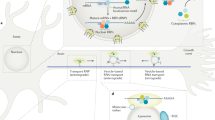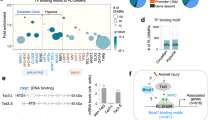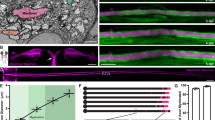Abstract
mRNA localization is an evolutionary conserved mechanism that underlies the establishment of cellular polarity and specialized cell functions. To identify mRNAs localized in subcellular compartments of developing neurons, we took an original approach that combines compartmentalized cultures of rat sympathetic neurons and sequential analysis of gene expression (SAGE). Unexpectedly, the most abundant transcript in axons was mRNA for myo-inositol monophosphatase-1 (Impa1), a key enzyme that regulates the inositol cycle and the main target of lithium in neurons. A novel localization element within the 3′ untranslated region of Impa1 mRNA specifically targeted Impa1 transcript to sympathetic neuron axons and regulated local IMPA1 translation in response to nerve growth factor (NGF). Selective silencing of IMPA1 synthesis in axons decreased nuclear CREB activation and induced axonal degeneration. These results provide insights into mRNA transport in axons and reveal a new NGF-responsive localization element that directs the targeting and local translation of an axonal transcript.
This is a preview of subscription content, access via your institution
Access options
Subscribe to this journal
Receive 12 print issues and online access
$209.00 per year
only $17.42 per issue
Buy this article
- Purchase on Springer Link
- Instant access to full article PDF
Prices may be subject to local taxes which are calculated during checkout








Similar content being viewed by others
Change history
19 April 2010
In the version of this article initially published, the last name of the fifth author was misspelled. The correct name is Serena De Vita. The error has been corrected in the HTML and PDF versions of the article.
References
Hengst, U. & Jaffrey, S.R. Function and translational regulation of mRNA in developing axons. Semin. Cell Dev. Biol. 18, 209–215 (2007).
Lin, A.C. & Holt, C.E. Local translation and directional steering in axons. EMBO J. 26, 3729–3736 (2007).
Campbell, D.S. & Holt, C.E. Chemotropic responses of retinal growth cones mediated by rapid local protein synthesis and degradation. Neuron 32, 1013–1026 (2001).
Wu, K.Y. et al. Local translation of RhoA regulates growth cone collapse. Nature 436, 1020–1024 (2005).
Zhang, X. & Poo, M.M. Localized synaptic potentiation by BDNF requires local protein synthesis in the developing axon. Neuron 36, 675–688 (2002).
Brittis, P.A., Lu, Q. & Flanagan, J.G. Axonal protein synthesis provides a mechanism for localized regulation at an intermediate target. Cell 110, 223–235 (2002).
Willis, D.E. et al. Extracellular stimuli specifically regulate localized levels of individual neuronal mRNAs. J. Cell Biol. 178, 965–980 (2007).
Velculescu, V.E., Vogelstein, B. & Kinzler, K.W. Analysing uncharted transcriptomes with SAGE. Trends Genet. 16, 423–425 (2000).
An, J.J. et al. Distinct role of long 3′ UTR BDNF mRNA in spine morphology and synaptic plasticity in hippocampal neurons. Cell 134, 175–187 (2008).
Mayford, M., Baranes, D., Podsypanina, K. & Kandel, E.R. The 3′-untranslated region of CaMKII alpha is a cis-acting signal for the localization and translation of mRNA in dendrites. Proc. Natl. Acad. Sci. USA 93, 13250–13255 (1996).
Bassell, G.J. et al. Sorting of beta-actin mRNA and protein to neurites and growth cones in culture. J. Neurosci. 18, 251–265 (1998).
Condeelis, J. & Singer, R.H. How and why does beta-actin mRNA target? Biol. Cell 97, 97–110 (2005).
Yudin, D. et al. Localized regulation of axonal RanGTPase controls retrograde injury signaling in peripheral nerve. Neuron 59, 241–252 (2008).
Zweifel, L.S., Kuruvilla, R. & Ginty, D.D. Functions and mechanisms of retrograde neurotrophin signalling. Nat. Rev. Neurosci. 6, 615–625 (2005).
Riccio, A., Pierchala, B., Ciarallo, C. & Ginty, D.D. An NGF-TrkA-mediated retrograde signal to transcription factor CREB in sympathetic neurons. Science 277, 1097–1100 (1997).
Riccio, A., Ahn, S., Davenport, C.M., Blendy, J. & Ginty, D.D. Mediation by a CREB family transcription factor of NGF-dependent survival of sympathetic neurons. Science 286, 2358–2361 (1999).
Watson, F.L. et al. Rapid nuclear responses to target-derived neurotrophins require retrograde transport of ligand-receptor complexes. J. Neurosci. 19, 7889–7900 (1999).
Ye, H., Kuruvilla, R., Zweifel, L.S. & Ginty, D.D. Evidence in support of signaling endosome-based retrograde survival of sympathetic neurons. Neuron 39, 57–68 (2003).
Campenot, R.B. Local control of neurite development by nerve growth factor. Proc. Natl. Acad. Sci. USA 74, 4516–4519 (1977).
Wang, S.M. Understanding SAGE data. Trends Genet. 23, 42–50 (2007).
Baugh, L.R., Hill, A.A., Brown, E.L. & Hunter, C.P. Quantitative analysis of mRNA amplification by in vitro transcription. Nucleic Acids Res. 29, E29 (2001).
Eng, H., Lund, K. & Campenot, R.B. Synthesis of beta-tubulin, actin, and other proteins in axons of sympathetic neurons in compartmented cultures. J. Neurosci. 19, 1–9 (1999).
Willis, D. et al. Differential transport and local translation of cytoskeletal, injury-response, and neurodegeneration protein mRNAs in axons. J. Neurosci. 25, 778–791 (2005).
Lee, S.K. & Hollenbeck, P.J. Organization and translation of mRNA in sympathetic axons. J. Cell Sci. 116, 4467–4478 (2003).
Huang, F., Chotiner, J.K. & Steward, O. The mRNA for elongation factor 1alpha is localized in dendrites and translated in response to treatments that induce long-term depression. J. Neurosci. 25, 7199–7209 (2005).
Cox, L.J., Hengst, U., Gurskaya, N.G., Lukyanov, K.A. & Jaffrey, S.R. Intra-axonal translation and retrograde trafficking of CREB promotes neuronal survival. Nat. Cell Biol. 10, 149–159 (2008).
Di Paolo, G. & De Camilli, P. Phosphoinositides in cell regulation and membrane dynamics. Nature 443, 651–657 (2006).
Irvine, R.F. & Schell, M.J. Back in the water: the return of the inositol phosphates. Nat. Rev. Mol. Cell Biol. 2, 327–338 (2001).
Engelman, J.A., Luo, J. & Cantley, L.C. The evolution of phosphatidylinositol 3-kinases as regulators of growth and metabolism. Nat. Rev. Genet. 7, 606–619 (2006).
Resnick, A.C. & Saiardi, A. Inositol polyphosphate multikinase: metabolic architect of nuclear inositides. Front. Biosci. 13, 856–866 (2008).
Berridge, M.J., Downes, C.P. & Hanley, M.R. Neural and developmental actions of lithium: a unifying hypothesis. Cell 59, 411–419 (1989).
Williams, R.S., Cheng, L., Mudge, A.W. & Harwood, A.J. A common mechanism of action for three mood-stabilizing drugs. Nature 417, 292–295 (2002).
Azevedo, C. & Saiardi, A. Extraction and analysis of soluble inositol polyphosphates from yeast. Nat. Protoc. 1, 2416–2422 (2006).
York, J.D. Regulation of nuclear processes by inositol polyphosphates. Biochim. Biophys. Acta 1761, 552–559 (2006).
Andreassi, C. & Riccio, A. To localize or not to localize: mRNA fate is in 3′UTR ends. Trends Cell Biol. 19, 465–474 (2009).
Aakalu, G., Smith, W.B., Nguyen, N., Jiang, C. & Schuman, E.M. Dynamic visualization of local protein synthesis in hippocampal neurons. Neuron 30, 489–502 (2001).
Nikolaev, A., McLaughlin, T., O'Leary, D.D. & Tessier-Lavigne, M. APP binds DR6 to trigger axon pruning and neuron death via distinct caspases. Nature 457, 981–989 (2009).
Machado-Vieira, R., Manji, H.K. & Zarate, C.A. Jr. The role of lithium in the treatment of bipolar disorder: convergent evidence for neurotrophic effects as a unifying hypothesis. Bipolar Disord. 11 (suppl. 2): 92–109 (2009).
Vance, J.E., De Chaves, E.P., Campenot, R.B. & Vance, D. E. Role of axons in membrane phospholipid synthesis in rat sympathetic neurons. Neurobiol. Aging 16, 493–498; discussion 498–499 (1995).
Martin, K.C. & Ephrussi, A. mRNA localization: gene expression in the spatial dimension. Cell 136, 719–730 (2009).
Zhang, H.L., Singer, R.H. & Bassell, G.J. Neurotrophin regulation of beta-actin mRNA and protein localization within growth cones. J. Cell Biol. 147, 59–70 (1999).
Yin, H.L. & Janmey, P.A. Phosphoinositide regulation of the actin cytoskeleton. Annu. Rev. Physiol. 65, 761–789 (2003).
Cryns, K. et al. IMPA1 is essential for embryonic development and lithium-like pilocarpine sensitivity. Neuropsychopharmacology 33, 674–684 (2008).
Tanizawa, Y. et al. Inositol monophosphatase regulates localization of synaptic components and behavior in the mature nervous system of C. elegans. Genes Dev. 20, 3296–3310 (2006).
Chau, J.F., Lee, M.K., Law, J.W., Chung, S.K. & Chung, S.S. Sodium/myo-inositol cotransporter-1 is essential for the development and function of the peripheral nerves. FASEB J. 19, 1887–1889 (2005).
Chen, Z.Y. et al. Genetic variant BDNF (Val66Met) polymorphism alters anxiety-related behavior. Science 314, 140–143 (2006).
Zuccato, C. & Cattaneo, E. Role of brain-derived neurotrophic factor in Huntington's disease. Prog. Neurobiol. 81, 294–330 (2007).
Silahtaroglu, A.N. et al. Detection of microRNAs in frozen tissue sections by fluorescence in situ hybridization using locked nucleic acid probes and tyramide signal amplification. Nat. Protoc. 2, 2520–2528 (2007).
Zuker, M. Mfold web server for nucleic acid folding and hybridization prediction. Nucleic Acids Res. 31, 3406–3415 (2003).
Acknowledgements
We are grateful to R. Kuruvilla, A. Lloyd and M. Raff for insightful comments and to all members of the Riccio laboratory for helpful discussion. CamKII-α-5′myrdGFP3′ expression vector was kindly provided by E. Schuman (California Institute of Technology). We thank A. Garedew for helping with the SAGE assay and statistical analysis. We also thank A. Vaughan for help with microscopy analysis. This work was supported by the UK Medical Research Council (MRC; Research Grant G0500/792) and the European Research Council (Marie Curie International Reintegration Grant MIRG-CT-2005-016501). A.R. is a recipient of a MRC Career Development Award (G117/533) and an MRC Senior Non-Clinical Fellowship (G0802010).
Author information
Authors and Affiliations
Contributions
C.A. helped to design the project, performed most of the experiments, analyzed the data and helped to write the manuscript. C.Z. performed the mRNA targeting assay and contributed to many other experiments throughout the study. R.M. was responsible for the bioinformatics analysis. S.D. and S.F. contributed to the SAGE assay. A.S. analyzed inositol polyphosphate content and helped write the manuscript. A.R., the senior author, designed the project, performed some of the RT-qPCR and axon degeneration experiments, analyzed the data and wrote the manuscript.
Corresponding author
Ethics declarations
Competing interests
The authors declare no competing financial interests.
Supplementary information
Supplementary Text and Figures
Supplementary Figures 1–8, Supplementary Table 1, Supplementary Methods and Supplementary Text (PDF 7371 kb)
Supplementary Movie 1
Time-lapse movie of GFP signal in sympathetic neurons deprived of NGF for 36 hours and exposed to NGF for 12 hours. (MOV 952 kb)
Rights and permissions
About this article
Cite this article
Andreassi, C., Zimmermann, C., Mitter, R. et al. An NGF-responsive element targets myo-inositol monophosphatase-1 mRNA to sympathetic neuron axons. Nat Neurosci 13, 291–301 (2010). https://doi.org/10.1038/nn.2486
Received:
Accepted:
Published:
Issue Date:
DOI: https://doi.org/10.1038/nn.2486
This article is cited by
-
Excess ribosomal protein production unbalances translation in a model of Fragile X Syndrome
Nature Communications (2022)
-
mLoc-mRNA: predicting multiple sub-cellular localization of mRNAs using random forest algorithm coupled with feature selection via elastic net
BMC Bioinformatics (2021)
-
An engineered channelrhodopsin optimized for axon terminal activation and circuit mapping
Communications Biology (2021)
-
The sympathetic nervous system in development and disease
Nature Reviews Neuroscience (2021)
-
Axonal mRNA localization and translation: local events with broad roles
Cellular and Molecular Life Sciences (2021)



